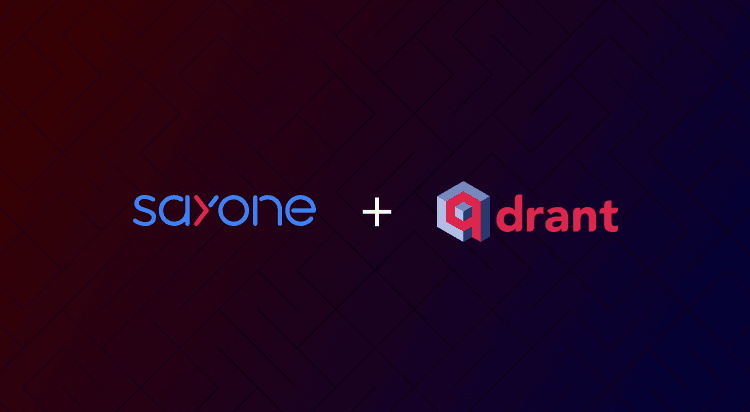
Subscribe to our Blog
We're committed to your privacy. SayOne uses the information you provide to us to contact you about our relevant content, products, and services. check out our privacy policy.

Renjith RajJune 16, 20258 min read

Generating table of contents...
We are excited to announce that SayOne has chosen to integrate Qdrant, a leader in vector search technology, into our technology stack. This strategic move will power our next-generation generative AI search and retrieval solutions. By incorporating Qdrant, we are setting the stage for delivering faster, more accurate, and highly context-aware AI-driven search experiences for our clients worldwide.
Selecting the right vector database was a pivotal decision in building our generative AI search solutions. We conducted an extensive evaluation of leading providers, focusing on compatibility with large language models (LLMs), scalability for large organizations, and real-time performance.
Qdrant distinguished itself with its strong integration capabilities for major LLM frameworks and its capacity to manage high-dimensional vector data with outstanding speed and accuracy. Its architecture, designed specifically for vector search, supports fast similarity queries and advanced metadata filtering, which is essential for providing context-aware, relevant results in enterprise applications.
Qdrant’s advanced vector search technology enables us to deliver AI solutions that are faster, more precise, and truly scalable for enterprise requirements. Its unique features allow our Next Gen AI search platform to provide highly relevant results while supporting the performance and security standards our clients expect.” - Real Prad
A key strength of Qdrant lies in its support for interactive deep learning in large-scale business applications.
With features like GPU-accelerated indexing and multi-vector support, Qdrant can ingest and search massive datasets in real time, making it ideal for situations where data is constantly changing. Its intelligent indexing and partitioning techniques, such as HNSW-based indexing and tenant-aware optimizations, help ensure that search operations remain quick and scalable, even as data volumes increase.
This directly accelerates both training and inference processes, which is critical for applications that demand low latency and high throughput.
From a deployment standpoint, Qdrant provides enterprise-grade features, including granular access controls, hybrid cloud options, and advanced monitoring. These capabilities make management easier, strengthen security, and offer the observability required for mission-critical AI workloads.
Our own benchmarking showed Qdrant’s ability to reduce query latency by over 90% compared to previous solutions, while also lowering infrastructure costs and increasing developer productivity.
By integrating Qdrant, we are positioned to deliver next-gen AI search and retrieval experiences that meet the evolving demands of modern enterprises.

Integrating Qdrant into SayOne’s generative AI stack has enabled our team to deliver Retrieval-Augmented Generation (RAG) solutions that combine the strengths of advanced vector search with the flexibility of modern AI frameworks.
Qdrant’s vector search engine is designed to efficiently store and retrieve high-dimensional embeddings, making it an ideal fit for our tech stack, which includes various machine learning frameworks and APIs.
Our developers are consistently at the forefront of building AI-based proofs of concept, utilizing a blend of cloud-native and open-source tools.
Our expertise in different web and mobile development frameworks allow us to deploy scalable image recognition and natural language processing capabilities directly in the cloud, while some model-sharing platforms provide fine-tuned, domain-specific AI functionalities for both text and multimodal data. JavaScript libraries enable rapid prototyping and experimentation, making AI accessible even for early-stage development.
Qdrant’s integration with various AI orchestration frameworks and popular embedding providers means we can construct RAG pipelines that dynamically retrieve relevant context from vast document stores. This context is then fed into large language models to generate accurate, context-aware responses.
Qdrant’s support for multi-vector search, efficient indexing, and real-time updates ensures that our generative AI applications remain responsive and scalable, even as data volumes grow or knowledge sources evolve.
By combining popular technologies with Qdrant for pre-training and fine-tuning LLM models, SayOne delivers enterprise-grade generative search solutions that provide fast, relevant, and reliable information access for a wide range of industries, from Healthcare to e-commerce.
Our tech stack, powered by Qdrant, is purpose-built to support large-scale deployments, high concurrency, and the demanding requirements of modern AI applications.
SayOne has harnessed the advanced capabilities of Qdrant’s vector search technology to build a diverse suite of generative AI applications tailored to the unique requirements of various industries. By integrating Qdrant into our generative AI stack, we have enabled organizations to unlock smarter, faster, and more contextually relevant search experiences.
Below are some of the key applications we have developed, each demonstrating how vector search forms the backbone of next-generation AI-powered solutions.
We developed a generative AI solution that transforms how users interact with internal knowledge bases. Traditionally, finding specific policies, procedures, or records required time-consuming manual searches.
With Qdrant’s vector search, users simply ask questions in natural language and receive precise, context-aware answers - even if their query doesn’t match document wording.
This solution is particularly valuable for legal teams, insurance providers, and for business intelligence. We have already secured projects with organizations in these sectors, helping them streamline knowledge retrieval.

We built a customer support platform that leverages Qdrant’s vector search to power AI-driven chatbots and agent-assist tools. How does it work? Well the customer queries are matched with the most relevant knowledge base articles, FAQs, or troubleshooting guides in real time.
This is done through the integration of AI Agents with Multi-Vector Intelligence. The vector-based retrieval ensures that even complex or ambiguous customer questions are understood and addressed promptly.
For live agents, the system suggests the best responses or resources, reducing response times and increasing accuracy.
For end-users, chatbots engage in natural, conversational exchanges, resolving issues efficiently and improving the overall support experience for both customers and support teams.
With Qdrant’s vector search at the core, we engineered a document summarization tool that enables users to quickly grasp the essence of lengthy files. The system scans and understands large volumes of text, such as legal contracts, research papers, or technical documentation, and generates concise, meaningful summaries.
By indexing documents as high-dimensional vectors, the AI can identify the most important sections and extract key takeaways in seconds.
Qdrant’s grouping requests - let us fetch the top N relevant segments per document in a single, efficient query.
We use Qdrant to encode document sections as vectors and retrieve the most relevant segments for summarization based on their similarity scores. This ensures our summaries are both concise and comprehensive, without repetitive information.
Our content creation assistant empowers marketing and creative teams to generate high-quality, relevant copy based on real-time search insights. By integrating Qdrant’s vector search, the tool can pull from a vast repository of brand assets, previous campaigns, and external sources to craft compelling messages tailored to specific audiences.
Users can input a topic or prompt, and the AI suggests ideas, drafts, or even complete articles that align with the organization’s tone and objectives.
This not only accelerates the content development process but also ensures consistency and creativity across all marketing channels.
In the healthcare sector, we built an AI-powered data analysis platform that leverages Qdrant’s vector search to navigate complex medical datasets. Medical professionals can search for patient records, clinical studies, or treatment guidelines using natural language queries.
The vector search engine retrieves the most relevant information, even when the data is unstructured or scattered across multiple sources.
This capability supports faster, more accurate diagnoses and treatment plans, as clinicians can access the latest research and best practices without manual cross-referencing.
Ultimately, this leads to improved patient outcomes and more efficient healthcare delivery.
Learn more about How to build Multi-Agent Clinical Intelligence Systems
For businesses seeking an edge in competitive intelligence, we developed a generative AI tool that utilizes Qdrant’s vector search to analyze competitors, industry trends, and customer sentiment.
The system ingests data from news articles, social media, product reviews, and market reports, transforming them into searchable vectors.
Users can query the platform to uncover emerging trends, benchmark against competitors, or identify potential threats and opportunities. The ability to synthesize vast, diverse datasets into actionable insights allows organizations to make strategic decisions with greater confidence and agility.
Our e-commerce personalization engine uses Qdrant’s vector search to deliver tailored product recommendations and search results. By analyzing user behavior, purchase history, and preferences, the system creates a unique profile for each shopper.
When users search for products or browse categories, the AI retrieves items that best match their interests, even predicting future needs.
Our commitment to building Next-Gen AI applications ensures that clients benefit from solutions tailored to their unique needs, with the flexibility to adapt as those needs evolve. As we continue to innovate and expand our offerings, SayOne remains dedicated to helping businesses stay ahead in the age of AI-driven transformation.
If you’re ready to explore how next-generation AI search can accelerate your organization’s growth and efficiency, connect with us to discover what’s possible with SayOne and Qdrant.

We're committed to your privacy. SayOne uses the information you provide to us to contact you about our relevant content, products, and services. check out our privacy policy.

About Author
Chief Technology Officer @ SayOne Technologies | Conversational AI, LLM


We collaborate with visionary leaders on projects that focus on quality and require the expertise of a highly-skilled and experienced team.